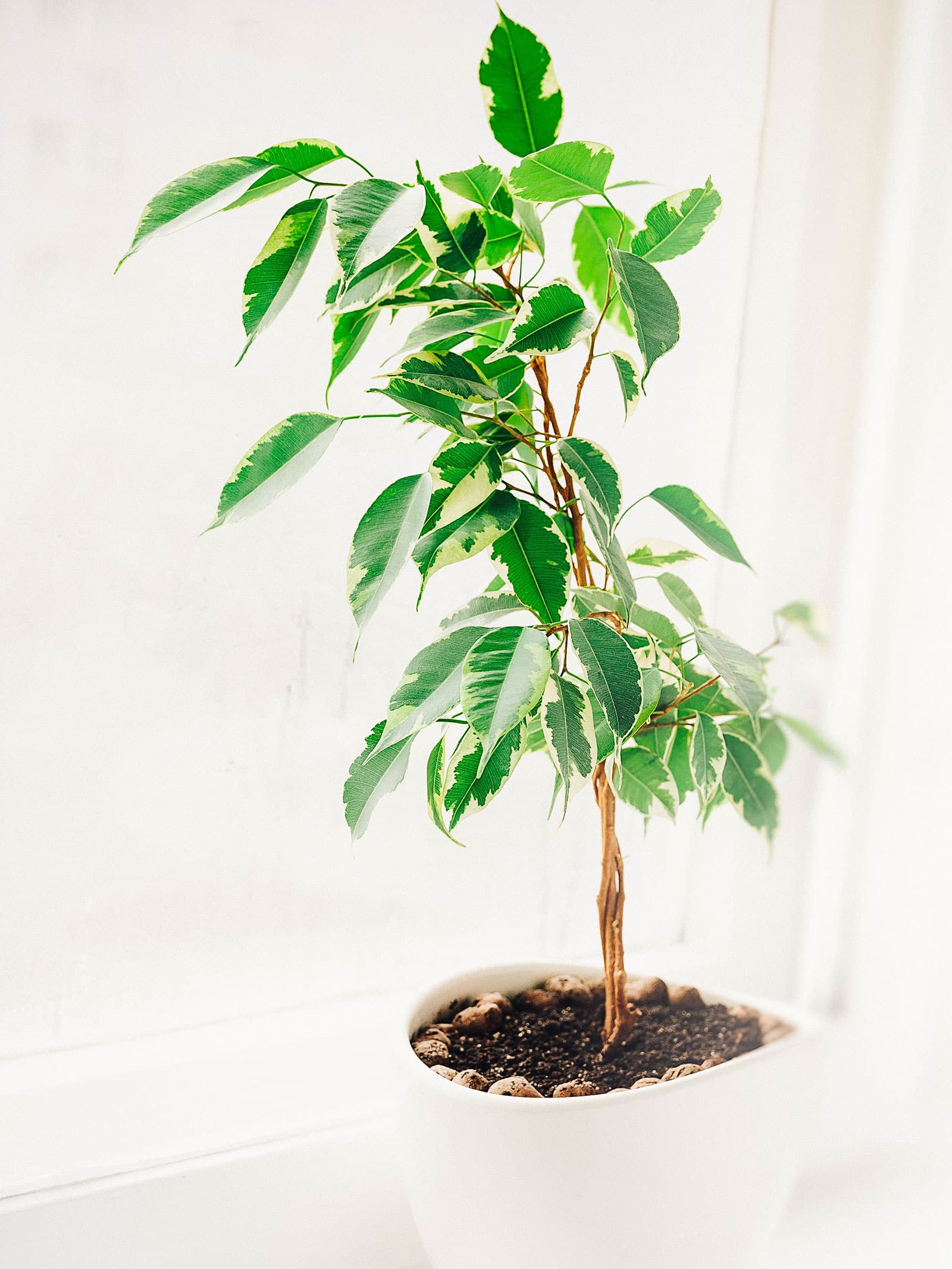If you’re looking for a small indoor tree to liven up your home, try a classic: Ficus benjamina, also known as the weeping fig. This elegant houseplant, easy to recognize with its small, pointy leaves, can live for years and grow fairly large with the right care.
Bookmark this guide for everything you need to know about Ficus benjamina and how to care for your weeping fig indoors!
| Common name(s) | Weeping fig |
| Scientific name | Ficus benjamina |
| Family | Moraceae |
| Height and spread | Up to 10 feet high and 2 feet wide (indoors) |
| Light | Indirect or direct light |
| Soil type | Standard soil with perlite |
| Water | Keep lightly moist |
Disclosure: If you shop from my article or make a purchase through one of my links, I may receive commissions on some of the products I recommend.

About Ficus benjamina
Description
It’s easy to see why houseplant enthusiasts have been growing Ficus benjamina in their homes for decades now. There’s a lot to love about this pretty indoor tree, a type of wild fig belonging to the mulberry family Moraceae.
One characteristic in particular that sets this Ficus apart from other tree-type houseplants, including its cousin, the popular fiddle leaf fig), is that F. benjamina has small leaves (usually up to 5 inches) rather than the big foliage you’d normally associate with a tree. The leaves on wild-type plants are a deep emerald green in color, pointy, and glossy.
The common name “weeping fig” is a reference to the fact that this species’ leaves and slender stems tend to arch downwards. Its droopy foliage doesn’t make this plant look sad, instead giving it an elegant look somewhat similar to a weeping willow tree.
There are different varieties of Ficus benjamina available, ranging from plants with braided stems to mini bonsai versions. I’ll talk about those in the next section.
Did you know?
A wild Ficus benjamina can grow into a full-sized tree, up to 100 feet high. In the home, it stays a lot smaller: usually under 10 feet.
Natural habitat
This houseplant is naturally found in Asia, occurring in much of Southeast Asia (Thailand, the Philippines, Vietnam, Indonesia, and more) and beyond (China, India, Bangladesh, etc.). It also grows in coastal northern and eastern Australia.
In the wild, Ficus benjamina favors tropical rainforests. In regions with warm climates, it’s also popular as an ornamental in parks and gardens; it works particularly well for creating dense, low hedges.
Did you know?
The IUCN Red List considers Ficus benjamina to be a species of Least Concern, meaning it’s not endangered in the wild. It notes the population size is likely stable.
As an invasive species
In some places, such as Florida, “escaped” weeping figs have managed to naturalize. The invasive plants apparently spread exclusively by means of asexual propagation, such as through root suckers or fallen twigs managing to root.
The reason a Ficus benjamina can’t really produce viable seeds outside of its natural habitat is fascinating. Each fig tree species, including this one, is associated with one or a few specific type(s) of fig wasp(s). Only this or these wasp(s), rather than “regular” pollinators like bees or butterflies, can pollinate its flowers.
As such, it’s important to ensure that the fig wasp associated with Ficus benjamina isn’t introduced anywhere outside of its natural range (like Florida). If it is, this plant would be able to spread a lot more rapidly.
Issues with this include it potentially crowding out important native greenery, damaging buildings and infrastructure with its roots, making messes when its fruits drop, and causing trouble when the trees inevitably fall when exposed to hurricane-force winds.
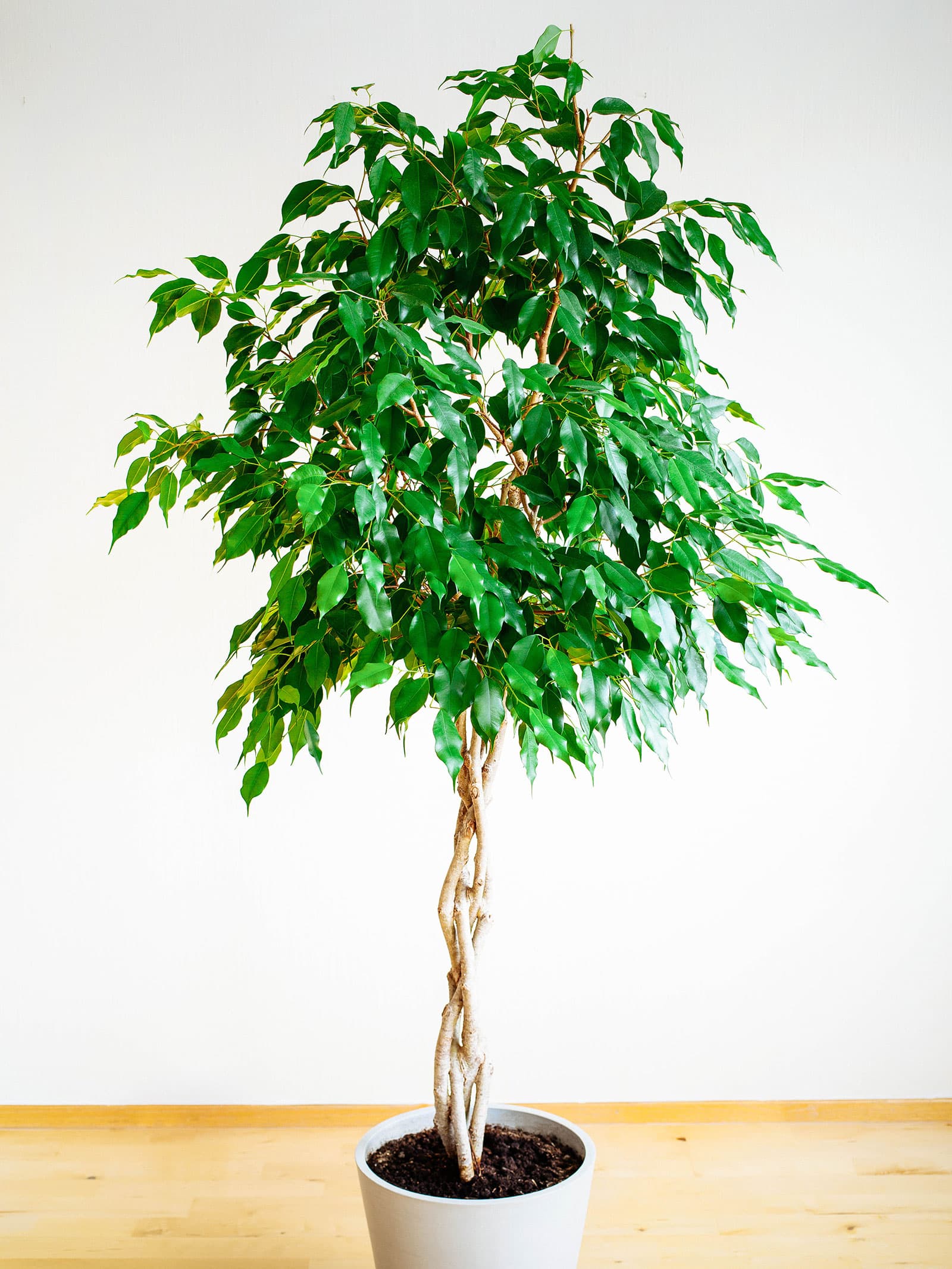
Ficus benjamina varieties
As is usual with houseplants that have been around for a long time, nurseries have created a whole bunch of selectively bred variations (cultivars) of Ficus benjamina. The original version has green foliage, but if you want something more interesting, you can also consider:
- Ficus benjamina bonsai: Not technically a cultivar, but very popular. This mini form is kept small on purpose, meaning it fits on a windowsill and is ideal if you don’t have much space to offer.
- Braided Ficus benjamina: Also not a cultivar, a braided Ficus consists of multiple stems in a single planter that are braided together when they’re still young and pliable (similar to money trees and cylindrical snake plants). You can keep braiding at home as your plant grows.
- Ficus benjamina ‘Exotica’: One of the oldest cultivars and the “parent” for many of those that have followed. The leaves can be either green or variegated, and the stems are often braided together.
- Ficus benjamina ‘Kinky’: A variegated cultivar with slightly curled leaves and a compact growth pattern. There’s also a green version called ‘Green Kinky’, which was patented in The Netherlands in 2010.
- Ficus benjamina ‘Anastasia’: A variegated cultivar that sports two different shades of green on its leaves. Often sold as a large, mature plant.
- Ficus benjamina ‘Starlight’: A gorgeous variegated cultivar with loads of cream coloration on its foliage.
- Ficus benjamina ‘Barok’: A rather strange variety with extreme leaf curl.
- Ficus benjamina ‘Twilight’: Somewhat similar to ‘Starlight’, but with more green.
- Ficus benjamina ‘Danielle’: Extra dark green and shiny leaves.
Where to buy
Ficus benjamina plants
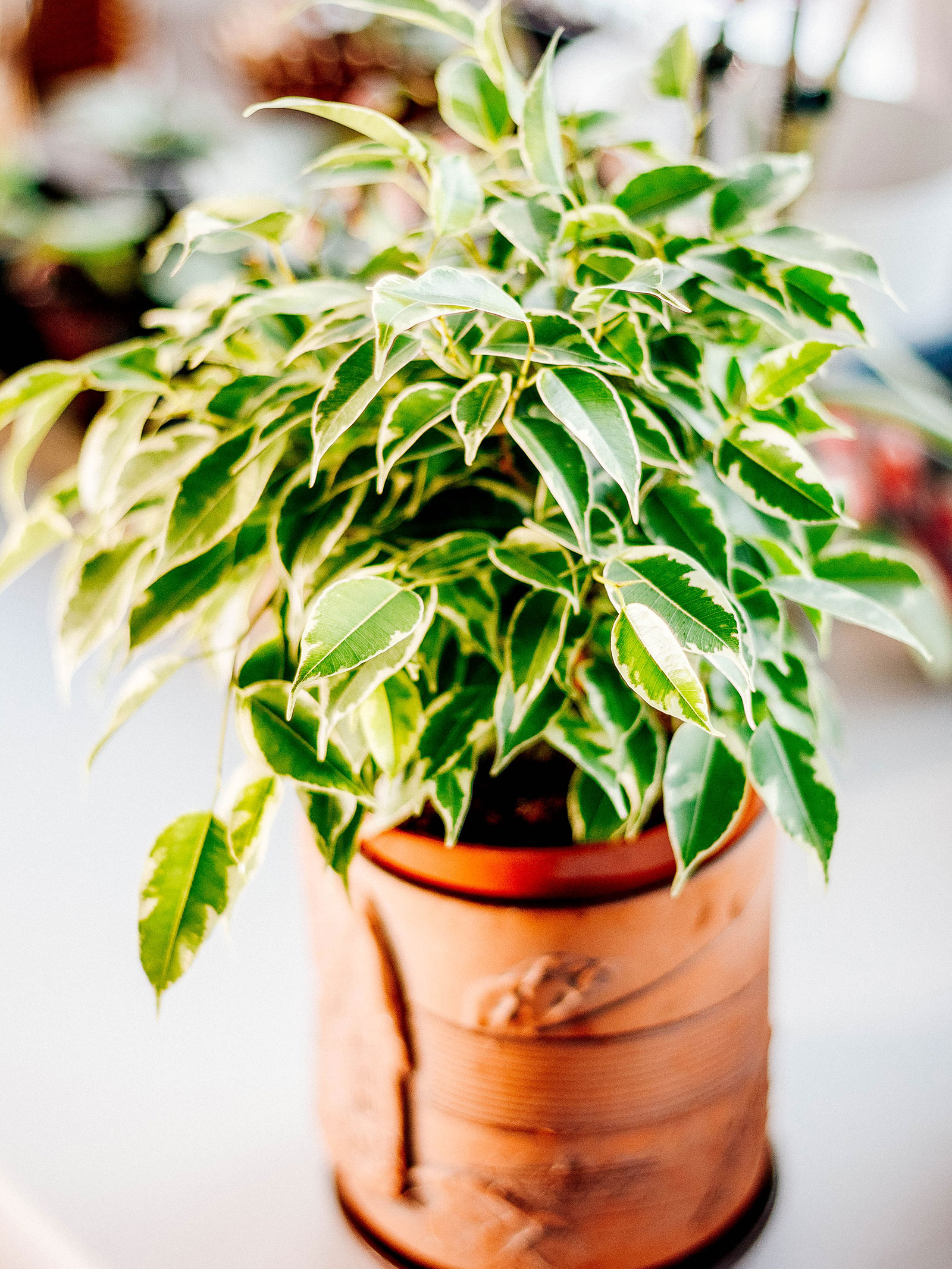
Caring for Ficus benjamina
Light and temperature
Although Ficus benjamina doesn’t need heaps of light, it’s not as opposed to the sun as many sources mention. Consider: This is a tree. It would get lots of direct sunlight in the wild! Please don’t keep yours in a dark corner, as it will be much more difficult to keep alive this way.
In your home, a weeping fig will do best if you place it right next to a window. Indirect light is fine, but this species definitely won’t say no to some direct rays either. The important thing is to acclimate it to more brightly-lit spots over the course of a few weeks to prevent leaf scorch.
In terms of temperature, this is a typical tropical. It doesn’t like the cold and can begin to struggle if temps drop below 50°F, so keep it away from A/C units or drafty windows. If you feel comfortable in your home (around room temperature), the same goes for your plant. High temperatures are not an issue.
Important
No Ficus likes being moved, but this one is particularly fussy about it. Pick a nice and bright, warm spot where your benjamina can hang out for the next couple of years, or you may end up having to deal with severe leaf loss every time you move your plant.
Water and humidity
As a tropical, Ficus benjamina likes its soil lightly moist. Letting the medium go entirely dry can cause leaf loss; on the other hand, if you consistently keep it too wet, deadly root rot may set in. It’s best to stick a finger in the planter to judge the moisture level rather than blindly watering on a weekly schedule.
Remember that the amount of water a plant needs depends on different factors, especially the season. When the days become shorter and temperatures drop, your Ficus will reduce its growth rate. As a result, it won’t need a drink nearly as often as it would in high summer.
It also isn’t too particular about humidity. The main thing is to avoid placing it too close to heaters or fireplaces, as the air around these is usually very dry. This can cause the leaves to crisp up.
Soil and planting
One of the nice things about this houseplant, which can be a bit of a drama queen in other aspects, is that it’s not picky when it comes to soil. A regular high-quality houseplant soil should work fine, although the ideal would be to add a handful of perlite for improved drainage.
If you really want to pamper your weeping fig, you can also add a little compost or worm castings for added nutrients. If you opt to do so, you won’t have to use fertilizer for the first year after repotting.
The type of planter you use for this Ficus doesn’t really matter as long as it has a drainage hole in the bottom to allow excess water to drain freely. You generally won’t have to repot often, as this species doesn’t mind being a little cramped. Every two to three years is usually fine. You can go up one pot size at a time.
Don’t reuse potting soil when you’re repotting. After multiple years in the same soil, your weeping fig will appreciate some fresh growing medium!
Recommended products for Ficus benjamina plant care:
- Good Earth Organics Premium Potting Soil
- Perfect Plants Organic Perlite
- Wiggle Worm Pure Organic Worm Castings
Fertilizing
Weeping figs aren’t known for being ultra-quick growers, but they definitely like getting a little fertilizer during the spring and summer growing season. No need to buy expensive or fancy products; a normal, balanced houseplant fertilizer works well. You could also consider one higher in nitrogen, which stimulates leaf growth.
Simply use fertilizer as described on the product packaging. It usually involves diluting the plant food in water and then watering your plants as normal.
Don’t fertilize if your Ficus isn’t doing well, and never do so in winter when it’s dormant. You can also skip the plant food if you’ve recently repotted your plant, especially if you used some compost.
Recommended fertilizers for Ficus benjamina:
- Elm Dirt Plant Juice Organic Fertilizer
- Houseplant Resource Center Liquid Fertilizer for Houseplants
- Bless Your Soil Fiddle Leaf Treats Indoor Plant Food
Pruning
You usually don’t need to prune a Ficus benjamina much. If it’s outgrown its current location in your home, you can re-shape it a little; head to the section on propagation below to find out what to do with the stems you’ve cut.
Dividing or repotting
Like other Ficus trees, Ficus benjamina doesn’t tend to produce offshoots indoors. This means it’s not a suitable candidate for division. If yours outgrows its planter, you’re best off just repotting it.
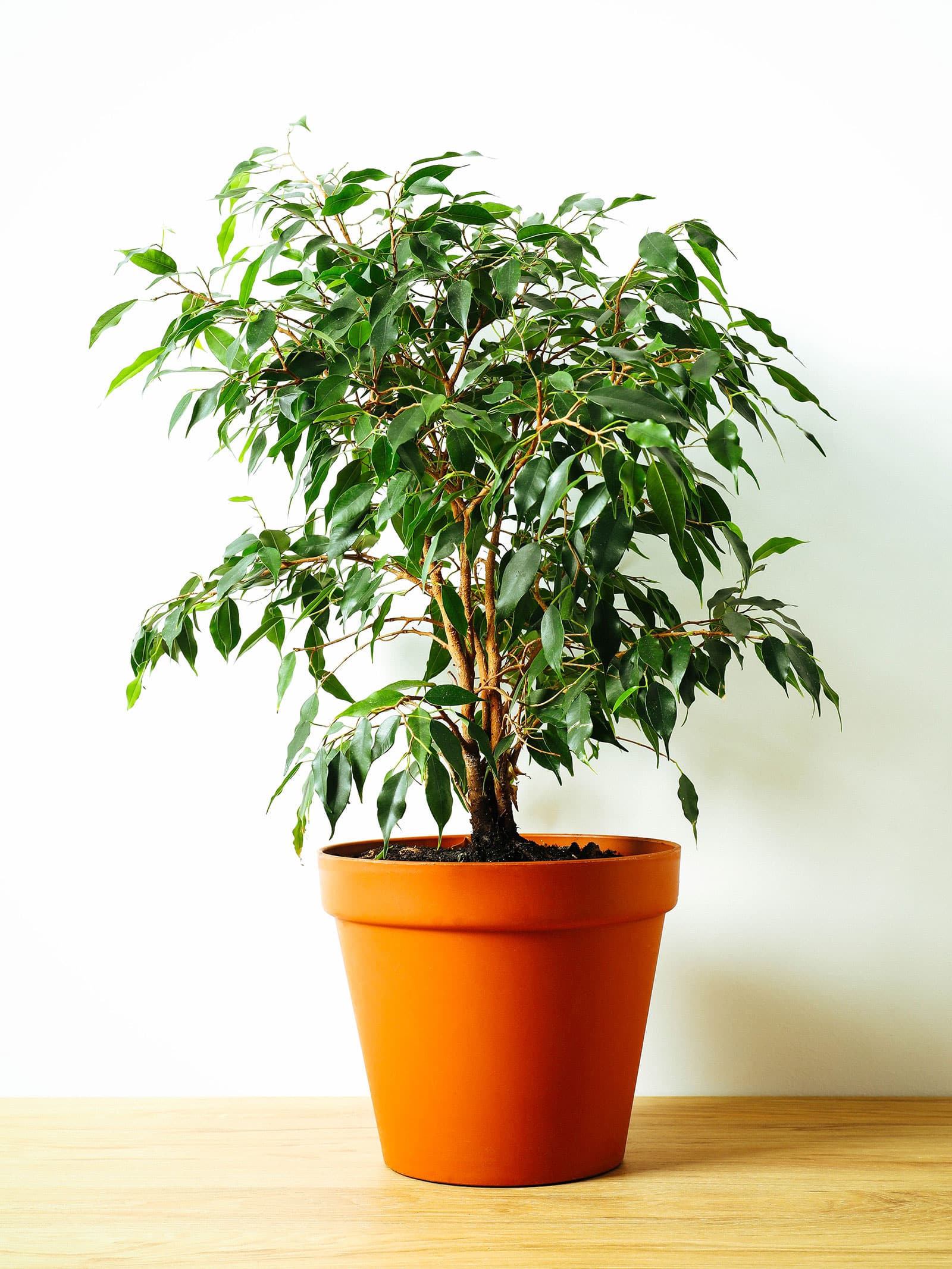
Propagating Ficus benjamina
Turning one Ficus benjamina into two (or several) without spending any money: sounds like magic, but it’s just propagation. Multiplying this houseplant using stem cuttings is a breeze.
Here’s how you do it:
First, use some clean pruning shears to remove one or multiple young, pliable shoots. Each cutting should be around 5 to 6 inches and have a few leaves.
- Water propagation: Remove the leaves from the lower half of the cuttings. Place the stems in a glass of water and set them in a warm and bright location (no direct sun).
- Soil propagation: Prepare a small planter with Ficus soil. Dip the undersides of the cuttings in some rooting hormone and stick them in the soil medium. Set them in a warm and bright location.
Next: patience! It can take a while before a cutting manages to establish itself, especially during winter.
If you opt to propagate in water, your new plants can be potted once the roots are around 2 inches in length. When propagating in potting soil, it can be more difficult to see whether a cutting has rooted or not. You can give the stems a little wiggle once every few weeks; if you feel any resistance, you can assume roots have appeared and your propagation attempt has been a success.
If you’d like to propagate a thicker, older Ficus benjamina stem, you could consider air layering. This technique ensures a branch roots before cutting it, making it ideal for older and harder stems that wouldn’t normally produce roots as easily in water or soil.
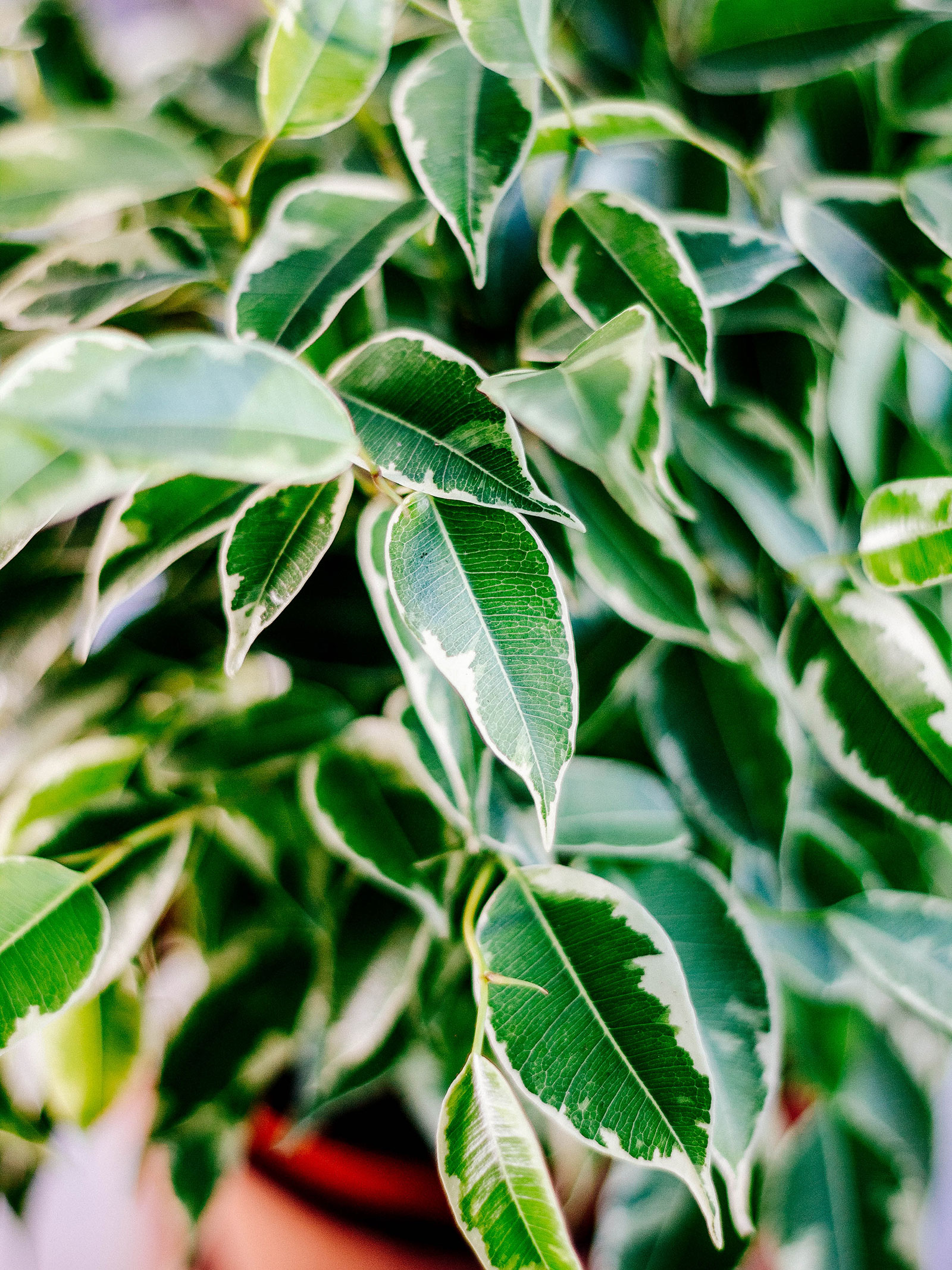
Common questions about Ficus benjamina care
Is a weeping fig toxic to cats and dogs?
Although a few nibbles won’t hurt your furry friend, this plant’s sap can cause irritation and tummy aches. If your cat or dog is vomiting or suffering from diarrhea after ingestion, be sure to offer plenty of water to avoid dehydration. Consider calling your vet to ask whether you should bring the animal in or not.
The ficin found in Ficus benjamina sap can also irritate your hands if you touch it. Folks who are sensitive to latex may want to consider wearing gloves when handling their plant.
Lastly, some people are actually full-on allergic to this Ficus. If your eyes begin to itch or you notice any asthmatic symptoms, you may be better off giving your benjamina to someone who isn’t affected.
Why is my weeping fig dropping leaves?
Yeah, they do that! Although they’re sturdy once they get used to a location, a Ficus benjamina will start dropping its foliage at the slightest inconvenience, especially when you move it. If you just brought your plant home, don’t panic and just give it some time.
If you didn’t move your Ficus, start by checking the temperature and soil. It may be cold, or the medium may be drying out too quickly (which can happen when it’s time to repot).


